TF 目前发布2.5 版本,之前阅读1.X官方文档,最近查看2.X的文档。
tensorflow是非常强的工具,生态庞大
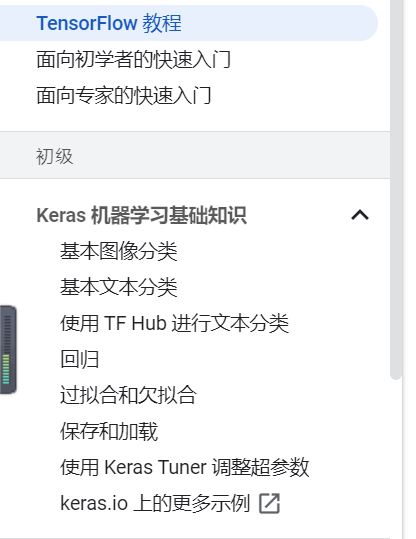
tensorflow提供了Keras的分支
这里不再提供Keras相关顺序模型教程。
关于环境:ubuntu的 GPU,需要cuda和nvcc

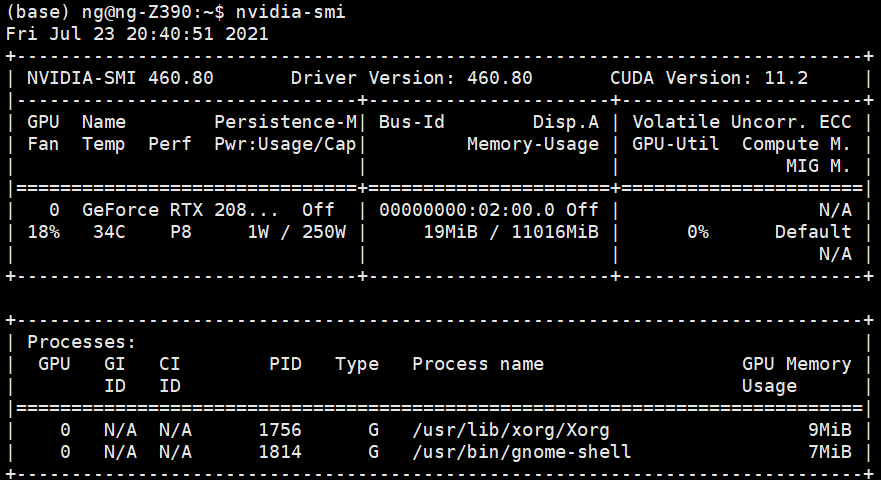
不会安装:查看
完整的Ubuntu18.04深度学习GPU环境配置,英伟达显卡驱动安装、cuda9.0安装、cudnn的安装、anaconda安装
不安装,直接翻墙用colab
测试GPU
>>> from tensorflow.python.client import device_lib >>> device_lib.list_local_devices()
这是意思是挂了一个显卡

具体查看官方文档:https://www.tensorflow.org/install
Define tensor constants.
import tensorflow as tf
# Create a Tensor.
hello = tf.constant("hello world")
hello
# Define tensor constants.
a = tf.constant(1)
b = tf.constant(6)
c = tf.constant(9)
# tensor变量的操作
# (+, *, ...)
add = tf.add(a, b)
sub = tf.subtract(a, b)
mul = tf.multiply(a, b)
div = tf.divide(a, b)
# 通过numpy返回数值 和torch一样
print("add =", add.numpy())
print("sub =", sub.numpy())
print("mul =", mul.numpy())
print("div =", div.numpy())
add = 7
sub = -5
mul = 6
div = 0.16666666666666666
mean = tf.reduce_mean([a, b, c])
sum_ = tf.reduce_sum([a, b, c])
# Access tensors value.
print("mean =", mean.numpy())
print("sum =", sum_ .numpy())
mean = 5
sum = 16
# Matrix multiplications.
matrix1 = tf.constant([[1., 2.], [3., 4.]])
matrix2 = tf.constant([[5., 6.], [7., 8.]])
product = tf.matmul(matrix1, matrix2)
product
<tf.Tensor: shape=(2, 2), dtype=float32, numpy=
array([[19., 22.],
[43., 50.]], dtype=float32)>
# Tensor to Numpy.
np_product = product.numpy()
print(type(np_product), np_product)
(numpy.ndarray,
array([[19., 22.],
[43., 50.]], dtype=float32))
Linear Regression
下面使用tensorflow快速构建线性回归模型,这里不使用kears的顺序模型,而是采用torch的模型定义的写法。
import numpy as np
import tensorflow as tf
# Parameters:
learning_rate = 0.01
training_steps = 1000
display_step = 50
# Training Data.
X = np.array([3.3,4.4,5.5,6.71,6.93,4.168,9.779,6.182,7.59,2.167,7.042,10.791,5.313,7.997,5.654,9.27,3.1])
Y = np.array([1.7,2.76,2.09,3.19,1.694,1.573,3.366,2.596,2.53,1.221,2.827,3.465,1.65,2.904,2.42,2.94,1.3])
random = np.random
# 权重和偏差,随机初始化。
W = tf.Variable(random.randn(), name="weight")
b = tf.Variable(random.randn(), name="bias")
# Linear regression (Wx + b).
def linear_regression(x):
return W * x + b
# Mean square error.
def mean_square(y_pred, y_true):
return tf.reduce_mean(tf.square(y_pred - y_true))
# 随机梯度下降优化器。
optimizer = tf.optimizers.SGD(learning_rate)
# 优化过程。
def run_optimization():
# 将计算包在GradientTape中,以便自动区分。
with tf.GradientTape() as g:
pred = linear_regression(X)
loss = mean_square(pred, Y)
# 计算梯度。
gradients = g.gradient(loss, [W, b])
# 按照梯度更新W和b。
optimizer.apply_gradients(zip(gradients, [W, b]))
#按给定的步数进行训练。
for step in range(1, training_steps + 1):
# 运行优化以更新W和b值。
run_optimization()
if step % display_step == 0:
pred = linear_regression(X)
loss = mean_square(pred, Y)
print("Step: %i, loss: %f, W: %f, b: %f" % (step, loss, W.numpy(), b.numpy()))
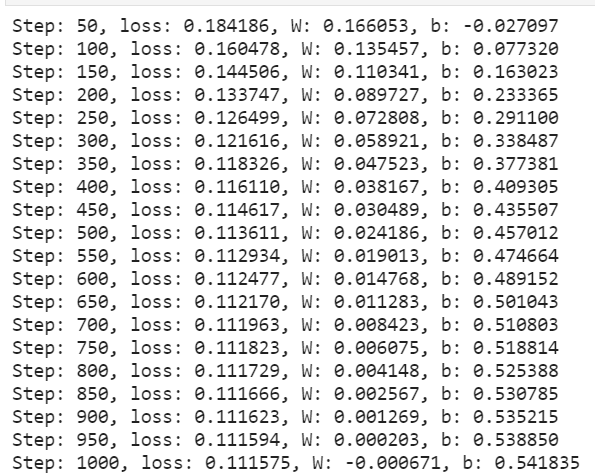
import matplotlib.pyplot as plt plt.plot(X, Y, 'ro', label='Original data') plt.plot(X, np.array(W * X + b), label='Fitted line') plt.legend() plt.show()
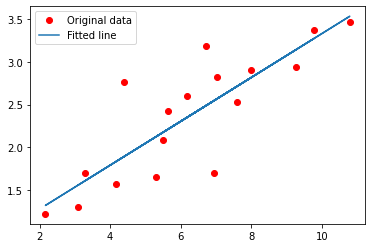
分类模型
本例使用MNIST手写数字
数据集包含60000个训练示例和10000个测试示例。
这些数字已经过大小标准化,并在一个固定大小的图像(28x28像素)中居中,值从0到255。
在本例中,每个图像将转换为float32,标准化为[0,1],并展平为784个特征(28×28)的一维数组。
import numpy as np
import tensorflow as tf
# MNIST data
num_classes = 10 # 0->9 digits
num_features = 784 # 28 * 28
# Parameters
lr = 0.01
batch_size = 256
display_step = 100
training_steps = 1000
# Prepare MNIST data
from tensorflow.keras.datasets import mnist
(x_train, y_train), (x_test, y_test) = mnist.load_data()
# Convert to Float32
x_train, x_test = np.array(x_train, np.float32), np.array(x_test, np.float32)
# Flatten images into 1-D vector of 784 dimensions (28 * 28)
x_train, x_test = x_train.reshape([-1, num_features]), x_test.reshape([-1, num_features])
# [0, 255] to [0, 1]
x_train, x_test = x_train / 255, x_test / 255
# 打乱顺序: tf.data API to shuffle and batch data
train_dataset = tf.data.Dataset.from_tensor_slices((x_train, y_train))
train_dataset = train_dataset.repeat().shuffle(5000).batch(batch_size=batch_size).prefetch(1)
# Weight of shape [784, 10] ~= [number_features, number_classes]
W = tf.Variable(tf.ones([num_features, num_classes]), name='weight')
# Bias of shape [10] ~= [number_classes]
b = tf.Variable(tf.zeros([num_classes]), name='bias')
# Logistic regression: W*x + b
def logistic_regression(x):
# 应用softmax函数将logit标准化为概率分布
out = tf.nn.softmax(tf.matmul(x, W) + b)
return out
# 交叉熵损失函数
def cross_entropy(y_pred, y_true):
# 将标签编码为一个one_hot向量
y_true = tf.one_hot(y_true, depth=num_classes)
# 剪裁预测值避免错误
y_pred = tf.clip_by_value(y_pred, 1e-9, 1)
# 计算交叉熵
cross_entropy = tf.reduce_mean(-tf.reduce_sum(y_true * tf.math.log(y_pred), 1))
return cross_entropy
# Accuracy
def accuracy(y_pred, y_true):
correct = tf.equal(tf.argmax(y_pred, 1), tf.cast(y_true, tf.int64))
return tf.reduce_mean(tf.cast(correct, tf.float32))
# 随机梯度下降优化器
optimizer = tf.optimizers.SGD(lr)
# Optimization
def run_optimization(x, y):
with tf.GradientTape() as g:
pred = logistic_regression(x)
loss = cross_entropy(y_pred=pred, y_true=y)
gradients = g.gradient(loss, [W, b])
optimizer.apply_gradients(zip(gradients, [W, b]))
# Training
for step, (batch_x, batch_y) in enumerate(train_dataset.take(training_steps), 1):
# Run the optimization to update W and b
run_optimization(x=batch_x, y=batch_y)
if step % display_step == 0:
pred = logistic_regression(batch_x)
loss = cross_entropy(y_pred=pred, y_true=batch_y)
acc = accuracy(y_pred=pred, y_true=batch_y)
print("Step: %i, loss: %f, accuracy: %f" % (step, loss, acc))
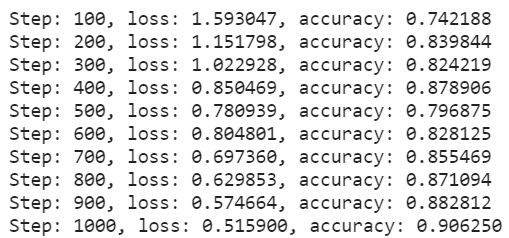
pred = logistic_regression(x_test)
print(f"Test Accuracy: {accuracy(pred, y_test)}")
Test Accuracy: 0.892300009727478
import matplotlib.pyplot as plt
n_images = 5
test_images = x_test[:n_images]
predictions = logistic_regression(test_images)
# 预测前5张
for i in range(n_images):
plt.imshow(np.reshape(test_images[i], [28, 28]), cmap='gray')
plt.show()
print("Model prediction: %i" % np.argmax(predictions.numpy()[i]))
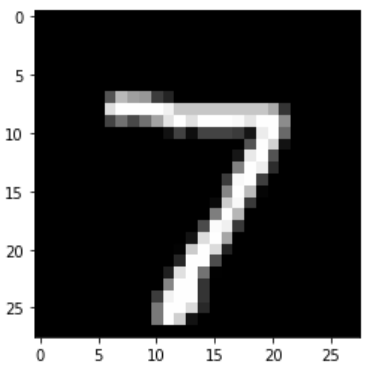
Model prediction: 7

Model prediction: 2
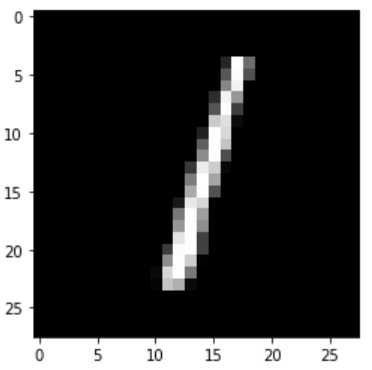
Model prediction: 1
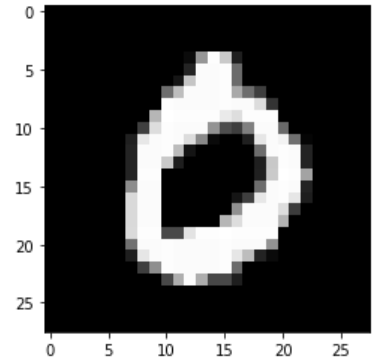
Model prediction: 0
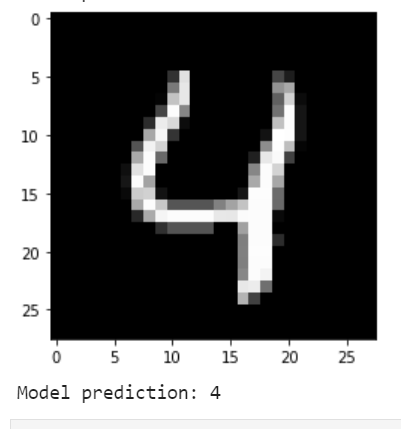
Model prediction: 4
以上就是tensorflow基本操作小白快速构建线性回归和分类模型的详细内容,更多关于tensorflow快速构建线性回归和分类模型的资料请关注自学编程网其它相关文章!

- 本文固定链接: https://zxbcw.cn/post/221194/
- 转载请注明:必须在正文中标注并保留原文链接
- QQ群: PHP高手阵营官方总群(344148542)
- QQ群: Yii2.0开发(304864863)
